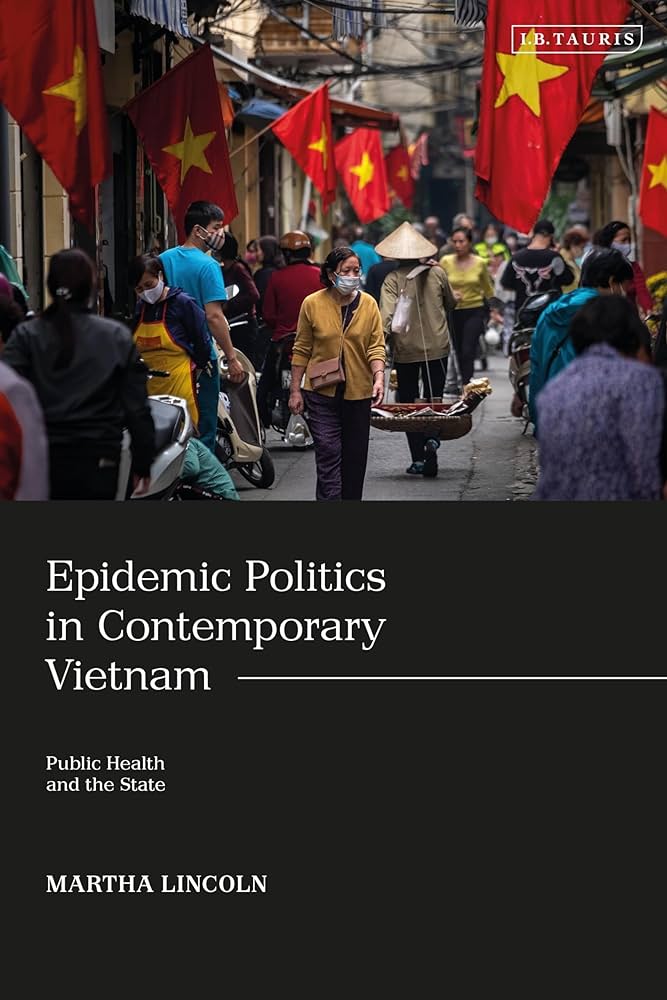Reviewed Book
Epidemic Politics in Contemporary Vietnam: Public Health and the State By Martha Lincoln, London: Bloomsbury Academic. 2022. 232 pp.1

C. Michele Thompson
Southern Connecticut State University
Martha Lincoln could not possibly have known, when she began developing her research on an outbreak of cholera in northern Vietnam into a book, that by the time she was finalizing its publication the world would be emerging from a pandemic that caused as much social and political upheaval as any cholera epidemic in history. The insights contained in this book regarding the cultural, economic, and political factors which shape any society’s response to epidemic disease are not only timely they are also thought provoking. In her examination of cholera as a disease with a broad global reach and a detailed global history Lincoln also addresses important contemporary interdisciplinary scholarly debates regarding post-socialist societies, poverty, epidemiology, othering, and knowledge production.
For example, Lincoln critiques “mainstream epidemiological accounts” which present poverty as a timeless easily defined variable rather than as a process which, particularly in the 21st century, can be exacerbated by development and a rush for modernization (8). This is a theme that recurs throughout the book. There are well presented illustrations from Vietnamese history in chapter one which makes the case that while cholera was “seen as the antithesis of modernity” given the complications imposed by rapid development this perspective has in more recent times when the market transition that began in the 1980s “affected the lives and health status of poor Hanoians” led to a very unfortunate underestimation of the strength of the epidemiological characteristics of cholera (29). Chapter two gives an intense, detailed, and quite technical examination of Hà Nội’s sanitary infrastructure-specifically provision of water and disposal of human waste. Lincoln makes a convincing case that while both the state and public focused on potentially contaminated types of food as an explanation for the cholera outbreaks that said, “food that causes cholera infection would be highly likely to have been originally contaminated by water” (59). Chapter three presents paradigms common to Medical History and Medical Anthropology regarding imaginary, or semi-imaginary, explanations for outbreaks of epidemic disease and then gives several detailed examples of this blame game in the case of the cholera outbreaks under discussion. The author makes a compelling case that these tropes incorporate “unresolved questions regarding gender norms, class relations, moral imaginaries, commercial practices, and everyday habitus” in contemporary Vietnam (81). In chapter four, Lincoln moves into a sophisticated, in depth, examination of one of these ‘explanations,’ namely that many of the cases of cholera could be attributed to eating contaminated dog meat. For Vietnamese, and some foreign, scientists, media figures, and member of the general public to blame eating dog meat, really dog meat sellers and eaters, despite the facts that “there are no known animal reservoirs for cholera besides plankton and shellfish,” and that “dogs and other mammals do not incubate the pathogen” fully supports Lincoln’s arguments in chapter three (103). Further, Lincoln also demonstrates that the lengths some scientists went to prove that dog meat was to blame for these cholera outbreaks fully illustrate how vulnerable science is to cultural biases. In chapter five the author gives an eye-opening account of both historic and contemporary practices in Vietnam of collecting, analyzing, and publicly presenting health data that brings to mind the statement often attributed to Mark Twain: lies, damn lies, and statistics.
Throughout this book the author’s interviews and her field work are firmly grounded in the particularities of contemporary northern Vietnam. However, the book reflects truly impressive interdisciplinary research and a detailed examination of the history of cholera in particular and epidemic disease in general. Lincolns’ bibliography contains numerous primary and secondary sources ranging from clinical, in some cases governmental, reports to works by anthropologists, geographers, historians, physicians, political scientists etc. The book could be read with much interest not only by anthropologists and medical anthropologists by also by historians, medical historians, political scientists, sociologists, and policy makers working with health and development. Indeed, chapter two alone could be read with profit by many in the field of development for Lincoln’s adept presentation of the hydrology and centuries of layers of hydraulic engineering of the sanitary infrastructure which the last three to four decades of “unsustainable urbanization” have “pushed to its limits.” (64)
Despite this book’s appropriate lean towards theory, it is very readable. This is, at least in part, because of the author’s regular return to direct quotes from, and descriptions of, her informants. For reasons imbedded in the parameters of Lincoln’s Vietnamese government approved research design, a disproportionate number of her informants are at least of retirement age and several of them are quite elderly. In less skillful hands than Lincoln’s this factor could have been detrimental. Instead, Lincoln uses the longitudinal information from her informants to demonstrate just how much of a negative impact development and moves towards a market economy have had on some elements of the Vietnamese population. Further, her informants’ depictions of their lived experience, over several decades, adds considerable warmth and color to the writing and really contributes to readability. This is one major reason this book would be an excellent choice for any upper-level undergraduate seminar or graduate class featuring cross cultural perspectives.
I have no serious criticism of this book, that being said a more thorough examination of the perspective of Vietnamese Traditional Medicine on epidemic disease in general, and severe gastrointestinal diseases in particular, would have been a positive addition to interpretation of popular explanations for cholera.
Epidemic Politics in Contemporary Vietnam: Public Health and the State by Martha Lincoln belongs on the bookshelf of anyone interested in contemporary Vietnam. It should also find a much broader scholarly audience among those doing health-related research on policies and interventions in the global south, particularly the global and transnational dimensions of health and health care.
Notes
1 Correction added on 16 January 2024, after first online publication: “Ed.” was removed from the article title.